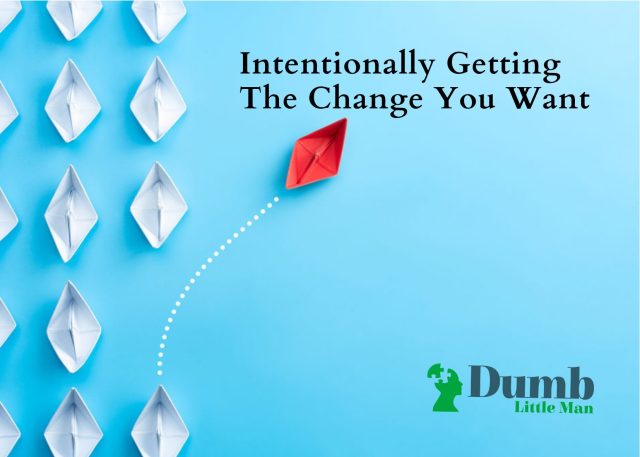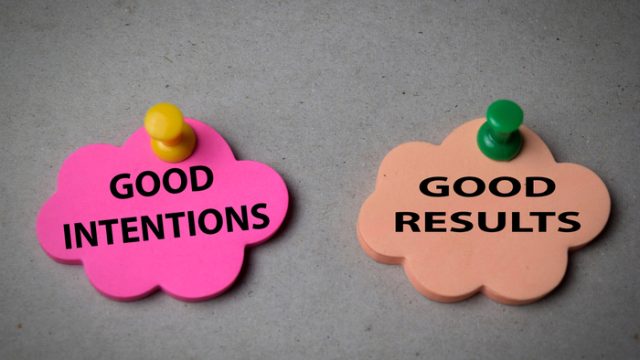Intentionally Getting The Change You Want
By Dr. Kurt Smith
January 10, 2024 • Fact checked by Dumb Little Man

We’re a few weeks into the new year and many of us have already broken all of the resolutions we were sure would stick this year. So, facing another year of wishing for and wondering how to make all the changes in your life you’d like to, you may be feeling stuck and confused about how to get there.
This is where intention setting comes in and can be extremely useful in helping you to achieve the changes you’d like to see.
Wondering what I mean? Allow me to explain.
Understanding Intention Setting
Intention setting is more than goal setting and is different than action planning. It’s larger, determined, more emotionally specific, and generally done or reflected upon on a daily basis.
To put it simply, intention setting is the practice of expressing in words a guiding value you plan to implement and then determining what actions you’ll take to do so. It’s not just about tangible goals and actions. Intention setting integrates the following into your plan for success.
- Heart
- Mind
- Emotions
- Values
For instance, rather than focusing on “finally getting that report done,” your intention for the day may be to “let go of the fear of failure,” which can help you overcome the things that hold you back.
So, rather than creating a list of boxes to check off, you’re working on developing personal tools to help you achieve those tangible goals, like finalizing that report you’ve been avoiding.
Another example of a daily intention is, “Today I plan to avoid distractions and stay focused.” Again, not a box to check or report to submit, but personal behavior and tool to help you achieve your goals.
Why Intention Setting Works
If it sounds like you should have incense burning while you do this, I understand. But believe me, intention setting isn’t in the same category as trying to read tea leaves or pull energy from crystals.
Intention setting is a way to achieve things in a manner that correlates with your own personal values, while also developing personal growth. It is one of the principal practices in positive psychology.
Positive psychology is an area of study that looks at how to approach life in a way that maximizes personal strengths through building upon,
- Thoughts
- Feelings
- Behaviors
Through setting an intention you create a directive to help guide you into success, changes, and accomplishments that match your values and lifestyle.
Intentions also allow for growth over time. While a resolution or a goal has only two overarching outcomes – you have achieved it or you haven’t, an intention is a daily work in progress and more about the journey of personal improvement.
Done right, all those goals and resolutions actually become more achievable and your likelihood of success on all fronts improves.
How To Set Your Intentions
To-do lists can be dashed off fairly quickly, but intention setting can take a bit of practice and thought to do effectively. Because the focus is more on the positive drive behind the task you might need to repeat the process a few times before you get the hang of it.

For instance, a common goal is to get in shape or lose weight. The pathway to achieving this goal often entails writing it down and laying out action steps like, exercising more, eating less, etc. Setting an intention that can help you achieve this goal is a little different.
Rather than starting with “lose weight,” you should first dig a bit deeper and consider why you want to lose weight. It might look something like this:
- I want to lose weight because if I do my health will improve and I will have more energy.
- More energy and better health give me more confidence and make me feel good about myself.
- When I feel good about myself I’m a happier and a better partner, parent, and friend.
So, my intention is to practice daily activities that improve my health.
Intention setting typically works best when done daily but also can have a larger component that addresses bigger changes over a period of time. Things like creating healthier habits, improving your relationship, or forging closer friendships are all larger intentions that take time. In order to achieve these, you would combine the larger intention with daily reminders to practice it.
So now your intention to practice daily activities to improve your health becomes, “Today I will do things that take care of my body.” Once you have committed to that you now conduct your day with that intention in mind. That might mean you take the stairs, skip the fries, go to the gym, and walk the dog, all of which are living by your intention for the day and contributing to the larger intention overall.
Intentions vs. To-Dos
Consider the intention-setting approach against the to-do list. In all likelihood, you would have written down something like “go to the gym.” If you have a busy day and don’t make it to the gym you feel as though you failed. Under the intention setting model, you are still able to experience success because the other behaviors you chose are in line with the intention you set.

Why is that distinction important? Because feeling successful is positive and creates a pathway for wanting to continue and push forward. Feeling as though you’ve failed can lead to poor self-esteem and a desire to just give up.
This isn’t to say that setting goals and action plans should be scrapped altogether. They have a place and often serve as a map for helping you get from one specific point to another. But they are finite and must continually be reset. Intention setting can be infinite (are we ever done trying to live a healthy life?) and can be added to and morph as our values in life change.
There’s never a bad time to start good habits, but the start of a new year provides a natural beginning. If you are looking to make the most of your desire for positive change, take a few minutes and add intention setting to your practice.
Dr. Kurt Smith
Dr. Kurt Smith is the Clinical Director of Guy Stuff Counseling & Coaching, a Northern California counseling practice that specializes in helping men and the women who love them. His expertise is in understanding men, their partners, and the unique relationship challenges couples face today. Dr. Kurt is a lover of dogs, sarcasm, everything outdoors, and helping those seeking to make their relationships better.


